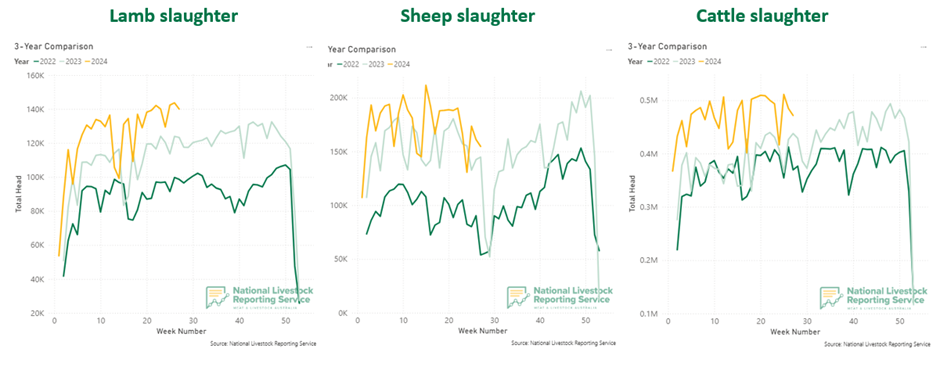Slaughter numbers exceed expectations
11 July 2024
Key points:
- Weekly NLRS lamb slaughter continued to break records throughout 2024, tipping 500,000 seven times.
- Price disparities between mutton and lamb drove volatile sheep slaughter.
- Cattle slaughter trends are aligning with 2017 and 2019 slaughter during the drought-led destocking period.
The National Livestock Reporting Service (NLRS) National Slaughter Report is a voluntary weekly slaughter report from processors nationwide. Weekly data collation provides a platform to track weekly slaughter trends beyond the delayed quarterly results published by the Australian Bureau of Statistics (ABS). Historically, the NLRS has covered approximately 80% of national slaughter when compared to ABS results.
Flock and herd sizes remained at long-term highs this year, and it’s anticipated this trend will continue due to a high production year in 2024.
This table shows the first six months of NLRS lamb, sheep and cattle slaughter figures.
|
Lamb |
Sheep |
Combined |
Cattle |
|
|
Average weekly |
467,259 |
174,528 |
641,787 |
124,013 |
|
Top weekly |
511,102 |
211,623 |
698,331 |
143,705 |
|
YTD 2024 |
12,615,999 |
4,712,255 |
17,328,254 |
3,348,345 |
|
YTD 2023 |
9,952,904 |
4,071,297 |
13,970,201 |
2,771,992 |
|
YTD (5-year average) |
10,155,301 |
3,317,857 |
13,473,159 |
2,846,245 |
Lamb
Weekly NLRS lamb slaughter continued to break records throughout 2024, tipping 500,000 seven times. The most significant reported slaughter was during June at 511,102 head. Average weekly slaughter remained above long-term trends at 467,259. Year-to-date, NLRS has reported over 12.6 million head , which is 27% above last year’s slaughter over the same period and 24% above five-year averages for the first six months of the year.
The 2023–24 supply has been strong, closely mimicking the elevated patterns of 2018–19. In 2019, drought-led turn-off caused a high supply of lambs through to winter and was followed by a glut in the third quarter as the supply of finished lambs dwindled. Currently, there is a seasonal reduction of lamb throughput in saleyards. This will likely carry through to processing numbers, as finished lambs become harder to find. If following 2019 trends, this reduction may remain until new season lambs enter the market.
Sheep
Weekly NLRS sheep slaughter has remained high, tracking above last year in all but four weeks. The average weekly sheep slaughter is 174,528 head, with the biggest processing week in April of 211,623 head. The NLRS has reported 4.7 million head over the year to date, 17% up against last year. However, when looking longer term, current year-to-date figures are 42% above the five-year average.
Due to the pricing disparities between mutton and lamb, sheep slaughter has been more volatile this year. High supply and significant pricing discounts for mutton allowed processors to switch between the two based on profit margins.
Cattle
This year’s cattle slaughter is tracking safely above five-year averages. Current weekly averages are 124,013 head, with the largest throughput week at 143,705. The year-to-date throughput of 3.3 million head is 21% above the same period last year and 18% above the average of the previous five years.
Cattle slaughter trends align more with those seen between 2017 and 2019 during the drought-led destocking period. Traditionally, cattle slaughter remains relatively flat across the year, with turn-off supported by a stable lot feeding industry and complementary northern and southern production systems.

Note: these figures are based on slaughter to week ending 7 July
Attribute to: Erin Lukey, MLA Senior Market Information Analyst


